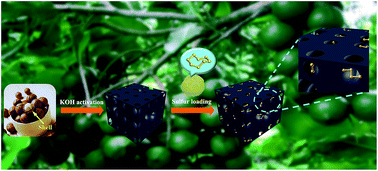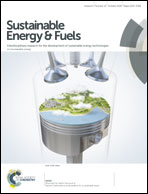A low cost ultra-microporous carbon scaffold with confined chain-like sulfur molecules as a superior cathode for lithium–sulfur batteries†
Abstract
Lithium–sulfur (Li–S) batteries with high energy density are one of the most promising energy storage systems. However, the shuttle effect due to the transition between ring-like S8 molecules and high order polysulfides (Li2Sn, 4 < n ≤ 8) hinders their practical application. Utilizing chain-like S2–4 molecules is considered to be an effective strategy to avoid this unfavorable process; however, the preparation of a carbon scaffold with ultra-micropores to constrain S2–4 molecules is challenging. In this study, a carbon scaffold derived from macadamia nut shell (MNS) with predominant ultra-micropores of sizes less than 0.6 nm is obtained by a simple KOH etching reaction followed by a calcination process. The calcined MNS (c-MNS) exhibits a high specific surface area (1687 m2 g−1), large pore volume (0.57 cm3 g−1), and large number of ultra-micropores (<0.6 nm) that account for 80% of the total specific surface area and 61.4% of the total pore volume. Then, a series of c-MNS/S composites are fabricated through a melt diffusion strategy. The electrochemical performances of c-MNS/S composites used as the cathodes of Li–S batteries are evaluated. The composites deliver a maximum reversible capacity of 1254 mA h g−1 at 0.1C rate (1C = 1675 mA g−1), with a capacity retention of 80% after 100 cycles, and can operate steadily up to 2C rate with a reversible capacity of 540 mA h g−1.



 Please wait while we load your content...
Please wait while we load your content...